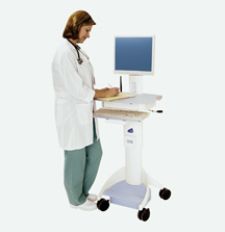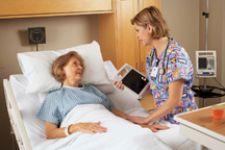
Nurses at Medical University of South Carolina (MUSC) in Charleston switched to mobile computing using wireless Motion Computing C5 tablet PCs with attached bar code readers. The tablets run the McKesson Horizon Clinicals application for patient data and vital signs entry.
The key front-line element in going to a paperless electronic medical record system and increasing speed and accuracy in recording real-time patient information, is use of mobile computers at the patient's bedside.
Hospitals that converted to mobile computing for patient data entry say the system has allowed for more time with patients, since clinicians don't have to write down the information and then go down the hall to enter it into a desktop computer. They also say the elimination of transcription has lead to greater accuracy and the information being immediately available to doctors.
“Mobile computing is getting ready to explode in healthcare,” said John L. Waller, M.D., director of informatics and professor at Medical University of South Carolina (MUSC) in Charleston.
His hospital made the conversion from pen and paper charting and data entry at a central nursing station, to mobile computing in the summer of 2007. The nursing staff uses wireless Motion Computing C5 tablet PCs with attached bar-code readers. The tablets, which run the McKesson Horizon Clinicals application, are mounted on Rubbermaid carts, but Dr. Waller says they easily detach to be hand-carried. He said the carts offer the advantage of having a normal keyboard for data entry instead of just using the tablet stylus. Vital sign information is entered by clinical assistants who are issued Motion Computing LE1700 tablet computers without bar-code readers.
“Using tablet PCs pushes the nurses to interact more with the patients,” Dr. Waller said. “The timeliness and accuracy in getting the information entered has been something that we have seen improvement in.”
In the initial pilot of McKesson's clinical documentation and bar-code medication administration solutions with the C5, the hospital saw an 18 percent improvement in patient vital sign charting accuracy and a significant reduction in charting delays, says Marilyn Schaffner, Ph.D., RN, CGRN, chief nursing officer at MUSC.
Dr. Waller said the time saved in charting has allowed nurses to spend more time with their patients. He said patient information has also been much easier to access and more up to date than with the previous system.
The bar-code readers are used primarily for medication administration. Dr. Waller said each patient has a unique bar-code on their hospital-issued ID wristbands, which are scanned and cross-checked along with the bar codes of medication being administered to check for potential interactions or drug allergies.
While MUSC currently uses 50 tablet PCs for nursing documentation, Dr. Waller said the goal is to add more and increase their usage in other areas, including more physician interface.
Carting it around
The computers used in mobile computing are generally smaller hand-held tablets, thin-client or laptop models. While some of these machines are carried from room to room, many are mounted on small carts. Installing computers on carts has several advantages over carrying tablet PCs, says Jon Lewis, RN, director of administrative operations for St. Mary’s Dean Ventures, a chain of four joint venture surgery centers operated by Dean Healthcare System and St. Mary’s Hospital in Madison, WI. In early 2007 his nurses began using 63 Wyse V90 thin client computers with sealed keyboards with run Epic OpTime OR management software. The computers are mounted on Flo Healthcare 1750 carts. He is very happy with the computers and the carts, which have significantly helped the surgery centers convert from paper charts to an electronic medical record system.
Lewis said the carts allow staff to have their hands free to work with patients, monitor equipment, and to more easily enter information into the computer. He said smaller tablet computers that use a stylus can be cumbersome if they are hand-held. The small footprint of the carts allows them to easily be maneuvered into patient rooms and around obstacles such as tables, chairs and equipment stands. The base of the Flo 1750 carts is weighted, which Lewis said helps add stability and prevent them from tipping over.
He said the computer is actually installed inside the cart to prevent it from being stolen. The cart also protects the expensive computer from being dropped or jarred, as might happen with hand-held computers. Lewis said this protection should help to extend the service life of the computers.
Lewis said the system allows nurses to be more efficient and data to be entered into patient files immediately. As nurses enter patient information, the patient information is immediately updated on large monitor “grease boards” at the central nursing stations. The information is also automatically entered into the patients EMR in the central server.
“The nurses had to have the ability to enter information in real time with the patient,” Lewis said. “It offers so many advantages over a paper record. It’s more efficient and there is more accuracy, which means better patient care because of reduced transcription errors.”
Evaluators from St. Mary’s Dean Ventures looked at various carts and chose one they thought would be ideal. However, when the
nursing staff began testing it on a daily basis, they were quickly dissatisfied and asked for a smaller cart that was more maneuverable and had better ergonomics.
“The important thing with a cart is to use it and test it in the environment where it will be used,” Lewis said.
Making the connection
Another key to successful conversion to mobile computing is reliable wireless service throughout the hospital.
The cart-based computers St. Mary's Dean Ventures use interface with a central server via wireless Wi-Fi. Lewis said the Wi-Fi system had to be installed throughout the centers to accommodate mobile computing, but will also serve other new technologies, including the introduction of Vocera voice-activated badges for instant communications between staff anywhere in
the buildings.
MUSC had to upgrade its Wi-Fi capability to handle the increased load mobile computing brings to a wireless network. Dr. Waller said hospitals need to coordinate in advance with their software, hardware and wireless vendors to ensure a smooth transition to a new mobile computing system. He said it is very important to ensure a Wi-Fi system can maintain constant connectivity from one Wi-Fi zone to another as computers are moved around the building. If not, he said they will constantly have to be rebooted.



 December 01, 2025
December 01, 2025 









